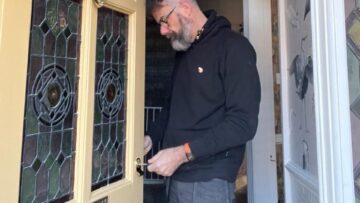Picture the scene: you come home after a long day, ready to relax, and discover your key won’t turn in the lock. What do you do? Firstly, don’t panic. Secondly, call Kew Locksmith Southport! We’ll fix the problem in no time.
It goes without saying that a fully functioning door lock is absolutely essential for your security and peace of mind. In this blog, Nick guides you through just what to do when faced with a broken door lock mechanism.
How does a door lock mechanism work?
At its core, a door lock mechanism is designed to secure a door in a closed position. This is achieved through a variety of components that work together to keep your door locked and fully secured.
Here are some of the basic components of your average door lock mechanism:
- Latch: A retractable bolt that engages with a strike plate on the door frame.
- Bolt: A more substantial locking mechanism, often deadlocked, needing a key to retract.
- Cylinder: Houses the key mechanism and controls the operation of the latch or bolt.
- Key: Unique pattern that interacts with the cylinder to unlock the mechanism.
- Handle or Knob: Operates the latch and sometimes the bolt.
- Strike Plate: Metal plate on the door frame where the latch or bolt engages.
Types of door locks in the UK
As you can imagine, I encounter all sorts of different door locks in my line of business. Here are some common types to give you a bit more of an idea as to what kind of lock you might have if a problem occurs.
Mortice Locks
Mortice looks are embedded in the door and are typically used in wooden front and back doors. This type of door lock mechanism features a space for the bolt to retreat into and several levers attached to the rear of the bolt.
The cut of the key matches the levers and when they align, the mechanism rotates to withdraw and extend the bolt.
Euro Cylinder Locks
Euro cylinder locks contain pins of varying lengths that press against the serrated edges of the key to detect the correct pattern for unlocking the door.
This type of door lock mechanism is widely used in external doors, especially uPVC and composite doors. They’re easy to change and can be upgraded to prevent picking, drilling and snapping.
Multi-Point Locks
Multi-point locks are a high-security option for external doors that engage multiple locking points along the door’s edge, offering better resistance to forced entry.
Common in composite doors and uPVC front, back and patio doors, multi-point locks generally use a Euro cylinder lock mechanism to engage several bolts at the same time.
What can cause a broken door lock?
The first step towards fixing a broken door look is to understand the culprit. Here are some common issues:
- The key won’t turn: This could be caused by a worn key, a broken key fragment stuck inside, or a misaligned strike plate.
- The latch won’t engage: This might be because of a broken spring within the lock mechanism, a loose internal component, or a build-up of dirt and debris.
- The lock feels loose: This could indicate loose screws holding the lock in place.
DIY Solutions (for minor issues)
If the problem seems relatively minor, there are a few DIY solutions you can try. For instance, if you find loose screws holding the lock in place, you might find that a quick tightening with a screwdriver can solve the problem.
If you spot any signs of misalignment, you might be able to fix this yourself. For example, if you find that a strike plate is misaligned, the solution might be as simple as readjusting its alignment using everyday tools.
Finally, if a lock could do with a clean, you could either use compressed air (if you’ve got access to a compressor) to remove dust or try a lubricant like graphite powder (avoid WD-40, as it can attract dirt).
Just remember to never force the lock! This can make any damage worse and make repairs more expensive.
When to call a locksmith
Unfortunately, there are going to be plenty of occasions when a DIY approach simply won’t be enough. Here are just a few examples of when you should leave it to the professionals and call in a locksmith:
- There’s a broken key stuck in the lock: Trying to remove it yourself can damage the mechanism further.
- The lock mechanism is complex: Modern locks often have intricate mechanisms best left to professionals.
- You’re facing an emergency: If you’re locked out or your security feels compromised, a locksmith can provide a fast and reliable solution.
Kew Locksmith Southport is here to help
A broken door lock shouldn’t be ignored. Taking action will help maintain the safety and security of your home. For a reliable and professional solution to your broken door lock, call Kew Locksmith Southport today.
I can quickly diagnose the problem, repair your lock efficiently and affordably, and even advise you on security upgrades if needed. I provide locksmith services in Southport, Formby and Ormskirk.
I’m available 24/7, 365 days a year and you’ll never pay a call-out fee for out-of-hours and weekend lock emergencies. If your door lock is broken and you need help, call me on 07454 416582 for a fast, effective solution.


